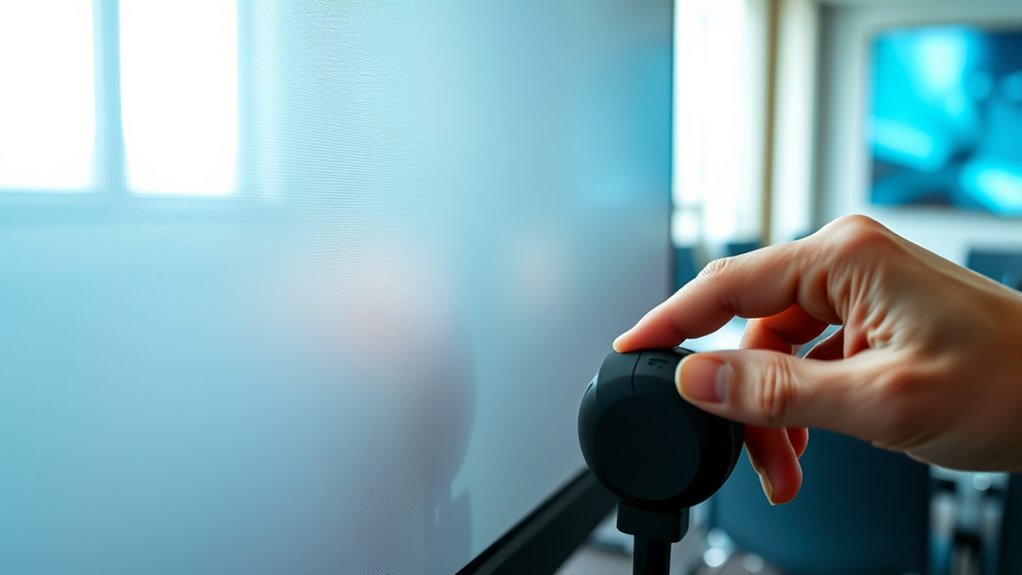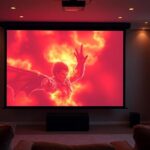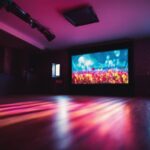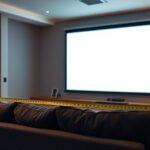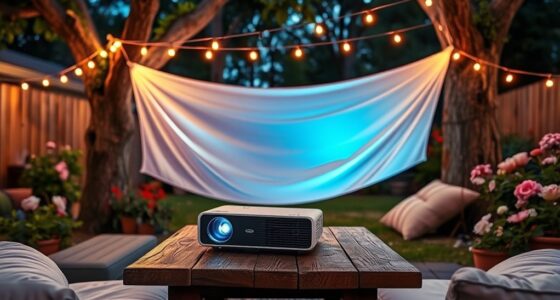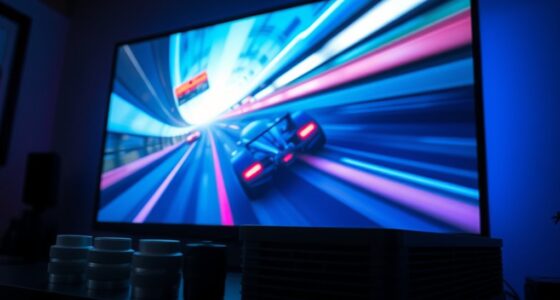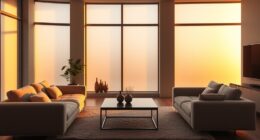To select the right screen gain, consider your environment’s ambient light, seating arrangement, and projection angle. Higher gain screens boost brightness and contrast in well-lit spaces but can cause hot spots if viewers sit off-center. Lower gain screens work better in darker rooms for better contrast and uniformity. Balance your projector’s brightness with screen gain to avoid overexposure or dull images. Keep exploring to find the perfect setup for your specific space.
Key Takeaways
- Assess ambient lighting; brighter rooms need higher gain screens to maintain image clarity.
- Consider projection angle; high gain screens suit direct viewing, while moderate gain offers better uniformity.
- Match screen gain with projector brightness and bulb condition for optimal image quality.
- Evaluate seating arrangements; front-facing seats benefit from higher gain, spread-out seats prefer moderate gain.
- Balance image brightness and contrast by selecting a gain that complements your environment and equipment setup.

Choosing the right screen gain is vital for achieving ideal image brightness and clarity in your projection setup. Your screen’s gain directly impacts how light reflects back to your audience, influencing both the brightness and contrast of the image. To make the best choice, you need to consider your projection angle and ambient lighting conditions. The projection angle, which is the angle at which your projector directs light onto the screen, affects how well the screen’s gain performs in different settings. A higher gain screen reflects more light directly back to viewers, making images appear brighter when viewed from the perfect angle. However, if your audience isn’t seated directly in front of the screen, a high gain surface can cause hot spots or uneven brightness. Conversely, a lower gain screen scatters light more evenly across a wider viewing cone, reducing hot spots but requiring a brighter projector to maintain image visibility.
Ambient lighting plays a vital role in selecting your screen gain as well. If you’re working in a space with a lot of ambient light—like a conference room with windows or a classroom during the day—you’ll want a screen with a higher gain. This helps compensate for the excess light that can wash out the image, ensuring that your content remains clear and vibrant. On the other hand, in a darkened home theater environment, a lower gain screen might be preferable. It offers softer reflections that reduce glare and preserve deep blacks, creating a more cinematic experience. Keep in mind that the combination of ambient lighting and projection angle will dictate the most suitable gain. For instance, in a setting where viewers are seated at various angles, a moderate gain screen can strike a balance between brightness and uniformity.
Additionally, understanding that bulb maintenance and proper projector care can influence the overall brightness and performance of your projection setup, it’s essential to keep your equipment in optimal condition. If your projector’s bulb is nearing the end of its lifespan, the image brightness may diminish, which can affect your gain choices. It’s important to visualize your space and seating arrangement when choosing gain. If your audience is positioned directly in front, a high gain screen can maximize brightness. But if viewers are spread out across different angles, look for a screen with moderate gain to ensure everyone sees a consistent picture. Additionally, consider the projector’s brightness capabilities—pairing a high gain screen with a less powerful projector can lead to overexposure, while a lower gain surface may require a more powerful projector. Ultimately, understanding the interplay between projection angle, ambient lighting, and your equipment will guide you toward the perfect gain for your environment, delivering crisp, bright images that enhance your viewing experience.
Frequently Asked Questions
How Does Ambient Light Affect Screen Gain Choices?
Ambient light considerably impacts your screen gain choice because higher ambient light requires a screen with lower reflectivity to prevent glare. If your environment has bright lighting, opt for a screen with a gain around 1.0 or lower to reduce reflections. Conversely, in darker rooms, higher gain screens enhance brightness and contrast. Consider your ambient lighting levels to select a screen gain that minimizes reflectivity and maximizes image clarity.
Can Screen Gain Impact Projector Lifespan?
Like a trusty steed that endures through time, your projector’s lifespan can be affected by screen gain if you ignore installation considerations. Higher gain screens may concentrate light, causing your projector to work harder and generate more heat, potentially impacting its durability. Properly selecting and installing the right gain screen helps prevent undue strain, ensuring both screen durability and a longer-lasting projector. Always consider gain in relation to your environment for ideal results.
Is High Gain Suitable for Large Venues?
Yes, high gain screens are suitable for large venues because they reflect more light, making images brighter even from a distance. When choosing one, consider the screen material, as some reflect light more effectively than others. Keep in mind that high gain screens often have narrower viewing angles, so if your audience is spread out or seated at different angles, it may affect their viewing experience.
How Does Screen Gain Influence Image Brightness?
Screen gain acts like a dimmer switch, directly influencing your image brightness. Higher gain screens boost brightness, making images pop, but can reduce image contrast and narrow viewing angles. Conversely, lower gain screens offer softer brightness with broader viewing angles and better contrast. So, your choice affects how vivid your picture appears and how well it’s seen from different spots, shaping your overall viewing experience.
Are There Trade-Offs With Low Gain Screens?
Yes, low gain screens have trade-offs. They reduce screen glare and improve viewing angles, making the image clearer from different positions. However, they also lower brightness, which may require a brighter projector and can affect visibility in well-lit rooms. You might notice less vivid images and reduced contrast, especially in large spaces. Balancing glare reduction and brightness is key, so consider your environment carefully before choosing a low gain screen.
Conclusion
Choosing the right screen gain can markedly enhance your viewing experience, especially in different lighting conditions. Did you know that screens with a gain of 1.0 provide the most balanced image, making them ideal for most environments? By understanding your space and projector specifications, you can select a gain that maximizes brightness and clarity. Don’t underestimate the impact of the right gain—it’s the key to immersive, crisp visuals that truly impress.
